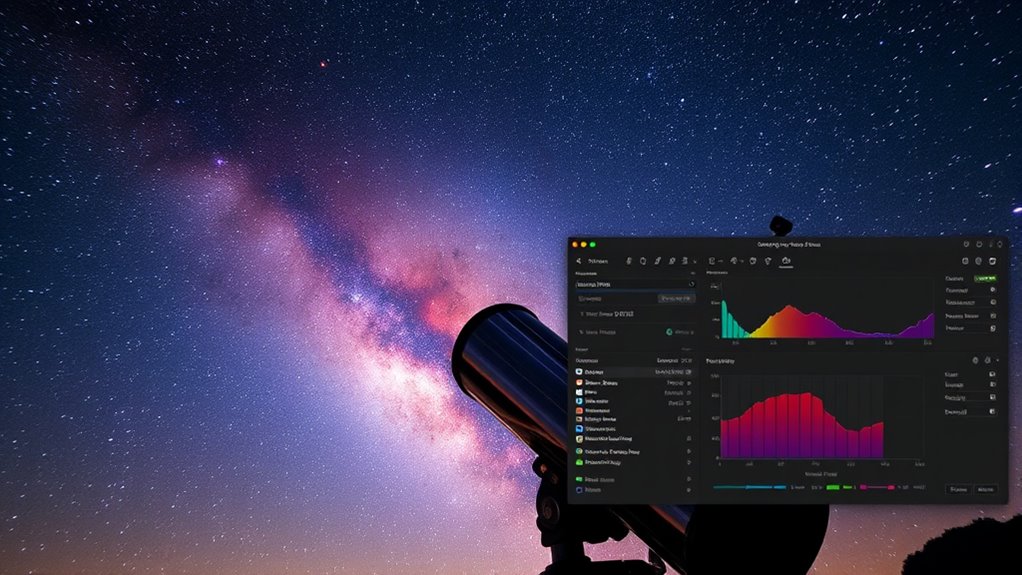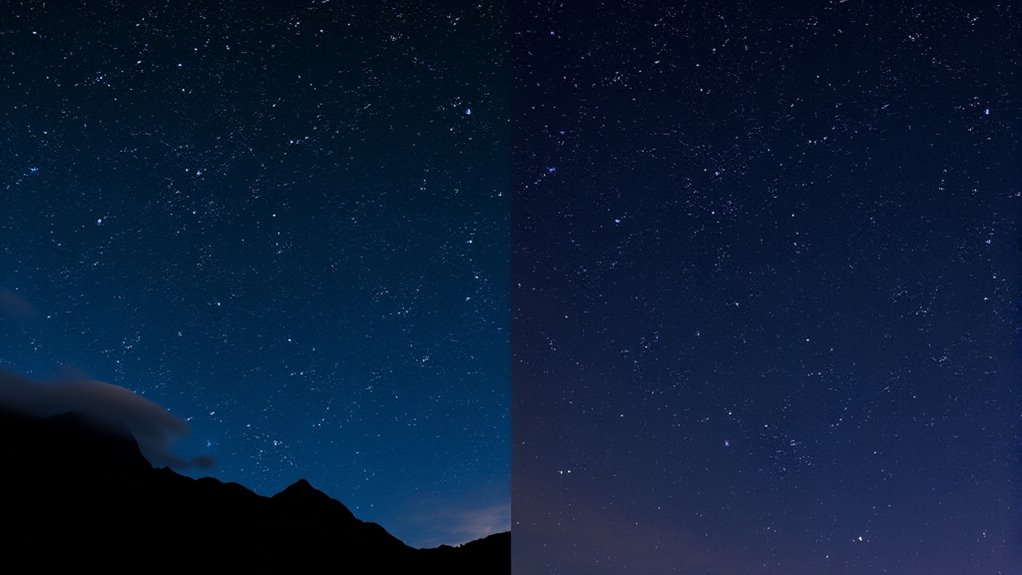Choosing between free and paid astrophotography stacking software depends on your goals and budget. Free options like DeepSkyStacker and RegiStax offer basic tools for alignment and noise reduction, making them suitable for beginners and casual hobbyists. Paid programs like PixInsight and AstroPixelProcessor provide advanced features for better detail, noise control, and processing efficiency, which are ideal for more serious astrophotographers. To discover how each option might fit your needs, keep exploring the details below.
Key Takeaways
- Free software like DeepSkyStacker offers basic stacking and noise reduction, suitable for beginners, but lacks advanced processing features.
- Paid options such as PixInsight provide sophisticated algorithms for noise reduction, detail enhancement, and atmospheric correction, ideal for professional results.
- Compatibility with specific camera models and hardware control features are generally better in paid software, improving workflow and automation.
- Free tools are often platform-independent and easy to use, while paid software may require more powerful hardware and offer more customization.
- Choice depends on your skill level, goals, and budget; free options suffice for casual use, whereas paid software delivers higher precision and efficiency.

Astrophotography stacking software is vital for capturing clear, detailed images of the night sky. When you’re stacking images, you’re fundamentally combining multiple exposures to enhance signal-to-noise ratio, revealing faint celestial objects that would otherwise be hidden. The quality of your results heavily depends on the software you choose, especially in terms of image processing capabilities and software compatibility. If you’re just starting out, free options can be tempting; however, paid software often offers more advanced features, streamlined workflows, and better support for different hardware setups.
Image processing is at the heart of astrophotography stacking software. Free programs like DeepSkyStacker or RegiStax provide basic tools to align and combine images, which are enough for hobbyists and beginners. These tools handle common tasks such as calibration, stacking, and some basic noise reduction. Still, they might lack sophisticated algorithms for optimizing image quality or correcting for atmospheric distortions. Paid options like PixInsight or AstroPixelProcessor, on the other hand, excel at advanced image processing, offering more control over noise reduction, contrast, and detail enhancement. They often include tools specifically designed for astrophotography, helping you extract the most detail from your captures.
Software compatibility is another critical factor. You want software that seamlessly integrates with your existing hardware and camera setups. Free tools usually support popular file formats and are compatible with most common operating systems. However, some paid software provides broader support for specialized camera models, mount control, and automation features. This can dramatically streamline your workflow, especially if you’re working with multiple devices or high-resolution images. Compatibility also extends to your computer’s hardware; paid software often requires more robust specifications but offers better performance and stability, which becomes vital when processing large image stacks.
While free stacking software can be sufficient for casual astrophotography, paid options tend to deliver more precise results and save you time with more efficient processing tools. If you’re serious about capturing high-quality images, investing in paid software might be worthwhile, especially since many programs offer trial versions. Additionally, understanding creative practice can help you develop more effective techniques and improve your results over time. Ultimately, your choice should depend on your goals, your hardware setup, and how much you’re willing to invest in your astrophotography journey. Regardless of your choice, focusing on good image processing techniques and ensuring software compatibility will help you produce stunning, detailed night sky images.
Frequently Asked Questions
Can Stacking Software Improve Images Taken With Smartphone Cameras?
Stacking software can definitely improve images taken with smartphone cameras by overcoming their limitations, like small sensors and noise. Using stacking techniques, you combine multiple shots to reduce noise and enhance details, resulting in clearer, more detailed astrophotography images. Even with smartphone limitations, applying stacking methods helps you get better results without needing professional equipment, making astrophotography more accessible and enjoyable.
Is There a Difference in Processing Speed Between Free and Paid Software?
They say “time is money,” and when it comes to stacking software, processing speed makes all the difference. Paid software often offers better efficiency, allowing you to process images faster without sacrificing quality. Free options might be slower due to limited optimization, but they still get the job done. Your choice depends on how much you value speed versus cost, and whether you need quick results or are willing to wait.
How User-Friendly Are Free Stacking Tools for Beginners?
You’ll find that free stacking tools vary in user-friendliness for beginners. Some have a simple interface, making it easy to learn, while others might feel overwhelming due to interface complexity. Luckily, many free options offer tutorials or online guides to help you get started. If you’re new to astrophotography, choose a tool with straightforward features and good tutorials, so you can learn quickly and enjoy capturing stunning images.
Do Paid Options Offer Better Support and Updates Than Free Software?
When choosing paid software, you get better customer support and more frequent updates, giving you peace of mind and smoother experiences. Free options might lack dedicated support and timely updates, leaving you to troubleshoot on your own. With paid tools, you benefit from prompt assistance and regular improvements, ensuring your astrophotography projects stay on track and evolve with new features. You invest in reliability, support, and ongoing development.
Are There Compatibility Issues With Specific Operating Systems?
You might face software compatibility issues depending on your operating system support. Some astrophotography stacking programs work seamlessly on Windows but may have limited or no support for Mac or Linux. It is crucial to check the software’s compatibility details before downloading. Paid options often offer broader operating system support and regular updates to fix compatibility problems, but always verify if your specific OS version is supported to avoid issues during your astrophotography sessions.
Conclusion
Whether you choose free or paid astrophotography stacking software, you’re investing in capturing stunning celestial images. Did you know that over 60% of amateur astronomers report improved results when using dedicated stacking tools? By understanding your needs and budget, you can select the right option to enhance your astrophotography experience. Remember, the right software can turn your night sky shots into breathtaking masterpieces—so explore your choices and aim for the stars!









